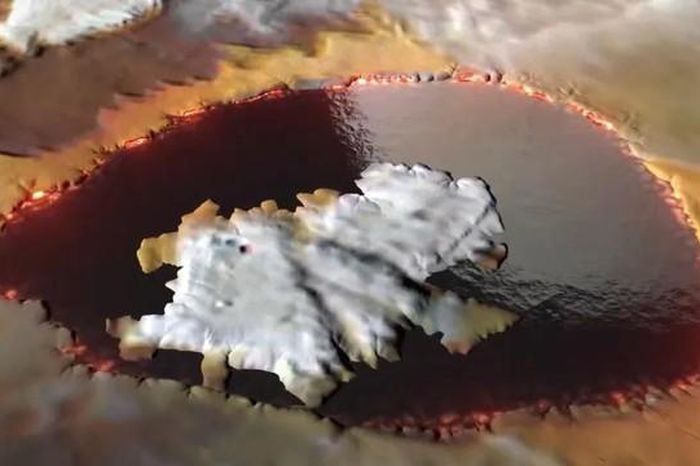NASA launches new Sun tracking tool
NASA has operated its latest tool on ISS to detect the total amount of light energy emitted by the Light and Sun Sensor (TSIS-1), installed on the ISS, fully operational. with all scientific data collection tools.
"TSIS-1 will help us understand how the effect of the sun impacts the Earth's radiation source, the ozone layer, atmospheric circulation and ecosystems, and the effects of energy transformation. solar energy for the Earth system and climate change. " Dong Wu, TSIS-1 Project Scientist at NASA's Goddard Space Center in the US said.
![]()
"This sensor data will give us a better understanding of Earth's primary energy supply and provide information to help improve models that simulate the planet's climate," Wu said.
The device was launched from Cape Canaveral Air Station in Florida on the SpaceX Falcon 9 spacecraft on December 15 last year. For more than two months, the team at the University of Colorado, Boulder in the US tested TSIS-1. The sensor studies the total amount of light energy emitted from the sun using the Irradiance Monitor, one of two sensors located on the ISS.
This new sensor gives us a total solar measurement of the Sun for 40 years. The second sensor on the ship, called Spectral Irradiance Monitor, measures how the Sun's energy is distributed in ultraviolet light, seen under infrared light technology.
Measuring the sun's energy distribution is important because each wavelength of light interacts with the Earth's atmosphere differently. For example, ultraviolet radiation measurements of ultraviolet rays are important to understand how ozone layer protects Earth life from ultraviolet rays.
You should read it
- Explore the universe through 5 NASA websites
- Li explained the law of conserving energy with just one coin
- Renewable energy 'goes beyond' all forms of new energy generation
- See the wild magnetic threads NASA found woven into the sun's atmosphere
- Meaning of energy ranking labels saves electricity on appliances
- Here's your chance to design a NASA payload for a Roomba-sized moon rover
- NASA opens the entire library of photos, videos and audio for free, anyone can see
- NASA will prioritize the recruitment of experienced scientists in blockchain and cryptocurrency
May be interested
- NASA will prioritize the recruitment of experienced scientists in blockchain and cryptocurrency
 nasa is becoming increasingly interested in the field of blockchain.
nasa is becoming increasingly interested in the field of blockchain. - NASA's top secret inventions have just been revealed
 recently, nasa has published many videos of tests of its top secret inventions to the public. those are the unsuccessful and 'weird' inventions that have always been kept secret by nasa.
recently, nasa has published many videos of tests of its top secret inventions to the public. those are the unsuccessful and 'weird' inventions that have always been kept secret by nasa. - Steps to block tracking pixels in Apple Mail
 today's technology makes email tracking very easy. any surprising details in your email will be sent back to the business or individual for marketing and advertising purposes, thanks to something called a 'tracking pixel'.
today's technology makes email tracking very easy. any surprising details in your email will be sent back to the business or individual for marketing and advertising purposes, thanks to something called a 'tracking pixel'. - Clip NASA: 'Glass lake' in the most terrible place in the solar system
 nasa has just revealed incredible images from the juno spacecraft's close flight to 'hellfire' io.
nasa has just revealed incredible images from the juno spacecraft's close flight to 'hellfire' io. - Did NASA ships indirectly bombard other planets?
 the suicide dive of the nasa spacecraft named dart caused such a strong impact that our neighboring planet also 'suffered the blow'.
the suicide dive of the nasa spacecraft named dart caused such a strong impact that our neighboring planet also 'suffered the blow'. - Why didn't NASA intend to return to the Moon?
 in 1969, nasa made history when it completed the mission to set foot on the moon. since then, conquering the moon has become the ambition of many countries around the world. but why has nearly 50 years passed without nasa planning to return to the moon?
in 1969, nasa made history when it completed the mission to set foot on the moon. since then, conquering the moon has become the ambition of many countries around the world. but why has nearly 50 years passed without nasa planning to return to the moon? - How to watch NASA and Russia launch a new crew to the ISS on Thursday
 one nasa astronaut and two russian cosmonauts are heading to the space station after spending their preflight days in quarantine.
one nasa astronaut and two russian cosmonauts are heading to the space station after spending their preflight days in quarantine. - Google plans to 'purge' third-party tracking cookies
 mountain view said it has completed a plan to end support for third-party tracking features on chrome internet browser.
mountain view said it has completed a plan to end support for third-party tracking features on chrome internet browser. - 5 ways to check who is following you online
 how much do you like online content? how much do you pay for such content? or you are like most other users on the internet, accept advertising and being followed.
how much do you like online content? how much do you pay for such content? or you are like most other users on the internet, accept advertising and being followed. - Leaving the solar system, the NASA ship sent back a confusing message
 one of nasa's spacecraft operating outside the heliosphere began sending meaningless messages to earth late last year, then went silent.
one of nasa's spacecraft operating outside the heliosphere began sending meaningless messages to earth late last year, then went silent.








 NASA began assembling Mars 2020 spacecraft
NASA began assembling Mars 2020 spacecraft Detects a hot alien planet, about the same size as the Earth
Detects a hot alien planet, about the same size as the Earth 7 alien planet is more exotic than science fiction movies
7 alien planet is more exotic than science fiction movies This is a photograph of the first black hole of mankind, located in a galaxy 55 million light-years from Earth
This is a photograph of the first black hole of mankind, located in a galaxy 55 million light-years from Earth Hell planet has snow even though the temperature is over 2,750 degrees Celsius
Hell planet has snow even though the temperature is over 2,750 degrees Celsius Discovered 20 Earth-like planets that could contain life
Discovered 20 Earth-like planets that could contain life